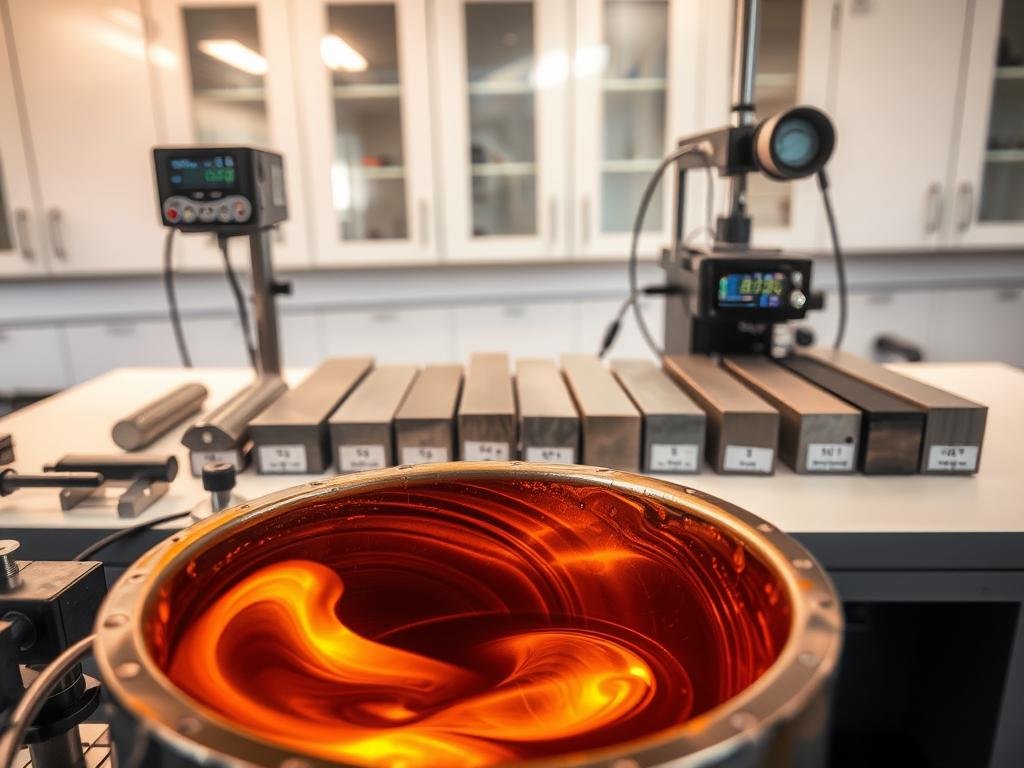The versatility of stainless steel lies in its exceptional corrosion resistance and durability, making it a prized alloy in various industries. A critical aspect of working with this material is understanding its thermal properties, particularly its melting point.
The melting point of stainless steel generally ranges between 1,370 to 1,530 degrees Celsius. This variation is largely dependent on the specific grade of steel and the proportion of metals used in the alloy.
This comprehensive guide focuses on the 304 grade, exploring its melting characteristics and the implications for industries that work with high-temperature applications. Understanding the melting behavior of 304 stainless steel is crucial for ensuring safety, reliability, and optimal performance in environments where it is used.
Understanding Melting Points in Metals
Understanding the melting point of metals is essential for industries that rely on materials with specific thermal properties. The melting point is a fundamental physical property that characterizes a material’s transition from a solid to a liquid state.
What Is a Melting Point?
A melting point is the temperature at which a solid substance transitions to a liquid state under normal atmospheric pressure. It is a critical property that helps determine the suitability of materials for various applications. When a solid is heated, its internal energy increases, causing the particles to vibrate more vigorously. At the melting temperature, these vibrations overcome the forces holding the particles together in a solid structure, allowing them to move freely as a liquid.
Why Melting Points Matter in Industrial Applications
Melting points are crucial in industrial settings for processes like welding, casting, and forging, where exceeding temperature thresholds can compromise structural integrity. For instance, understanding the melting point of steel is vital for high-heat applications such as industrial ovens and power generation equipment. The melting point also provides insights into a material’s purity, as impurities can significantly alter the temperature at which melting occurs.
| Material | Melting Point (°C) | Application |
|---|---|---|
| Pure Iron | 1538 | Steel production |
| 304 Stainless Steel | 1400-1450 | Chemical reactors, kitchen equipment |
| Carbon Steel | 1425-1540 | Construction, machinery |
As noted by metallurgy experts, “The melting point of an alloy like steel is not a single temperature but a range, due to the presence of multiple elements with different melting temperatures.” This characteristic is crucial for selecting materials for specific industrial applications.
The 304 Stainless Steel Melting Point
304 stainless steel’s melting point is a vital property that influences its suitability for different applications. The melting behavior of this alloy is crucial in determining its performance under various conditions.
Exact Temperature Range
The melting point of 304 stainless steel ranges from 1,400 to 1,450 degrees Celsius (2,552 to 2,642 degrees Fahrenheit), depending on its composition and specific alloy variants. This specific temperature range is determined by the precise composition of 304 stainless steel, particularly its chromium and nickel content.
How It Compares to Other Metals
When compared to other metals, 304 stainless steel has a significantly higher melting point than aluminum (660°C), copper (1,085°C), and brass (900-940°C), making it suitable for high-temperature applications. The relatively high melting point of 304 stainless steel contributes to its excellent performance in elevated temperature environments where other metals might fail.
Composition of 304 Stainless Steel
304 stainless steel is primarily made up of iron, with significant additions of other key elements. This alloy is a type of austenitic stainless steel, known for its excellent corrosion resistance and versatility in various applications.
Key Elements in the Alloy
The primary components of 304 stainless steel include iron (66-74%), chromium (18-20%), and nickel (8-10.5%). Chromium is a crucial element that enhances corrosion resistance, while nickel contributes to the alloy’s ductility and overall strength. Minor elements such as carbon, manganese, silicon, phosphorus, and sulfur are also present, playing significant roles in determining the alloy’s properties.

How Composition Affects Melting Point
The precise balance of elements in 304 stainless steel’s composition directly influences its melting point. Chromium tends to increase the melting point, while nickel typically lowers it. The careful control of composition during manufacturing ensures consistent melting point characteristics across different batches. Understanding how each element affects the melting point helps metallurgists and engineers optimize 304 stainless steel for specific high-temperature applications.
Factors That Influence Stainless Steel Melting Points
Understanding the melting point of stainless steel requires examining various influencing factors. The melting behavior of stainless steel is not solely determined by its composition; other critical factors play significant roles.
Crystal Structure Impact
The crystal structure of stainless steel significantly affects its melting point. Austenitic stainless steels, like 304, have a face-centered cubic (FCC) structure, which generally results in a lower melting point compared to ferritic grades with body-centered cubic (BCC) structures.
Effect of Alloying Elements
Alloying elements are crucial in determining the melting points of stainless steel. Elements such as chromium tend to raise the melting point, while nickel and manganese typically lower it. The specific percentages of these elements create complex interactions that establish the final melting point range.
Environmental Factors
External factors, including pressure and atmosphere, can alter the melting point of stainless steel. Increased pressure typically raises the melting point, while certain gases or contaminants in the atmosphere may influence the alloy’s behavior at high temperatures.
| Factor | Effect on Melting Point |
|---|---|
| Crystal Structure (FCC vs. BCC) | FCC generally lowers melting point |
| Alloying Elements (Cr, Ni, Mn) | Varying effects: Cr raises, Ni and Mn lower |
| Pressure | Increased pressure raises melting point |
How to Determine the Melting Point of Stainless Steel
To understand the melting behavior of stainless steel, one must employ accurate testing techniques. Determining the melting point involves precise measurements and specialized equipment. Various methods are utilized in both laboratory and industrial settings.
Laboratory Testing Methods
Laboratory methods for determining the melting point of stainless steel include Differential Scanning Calorimetry (DSC), which measures the heat flow into or out of a sample as it is heated. The capillary method is also commonly used, where a sample is packed into a thin-walled tube and gradually heated until it reaches a completely liquid state.
- DSC is a primary method that identifies the precise temperature at which phase transition occurs.
- Thermocouples and pyrometry techniques provide accurate temperature measurements during the melting process.
Industrial Measurement Techniques
Industrial settings often employ optical observation techniques, where trained technicians monitor visual changes in the material structure as heat is applied. Modern facilities may also use advanced spectroscopic methods that analyze changes in light absorption or emission as materials approach their melting points.
These testing processes must be conducted under controlled conditions to ensure accurate results, as environmental factors can significantly influence measurements.
Comparing Melting Points Across Stainless Steel Grades
Understanding the melting points of various stainless steel grades is crucial for industrial applications. The melting behavior of stainless steel is influenced by its composition, with different grades exhibiting distinct melting characteristics.
Austenitic Stainless Steels
Austenitic stainless steels, such as grades 304 and 316, generally have lower melting points due to their higher nickel content. For instance, the melting point of 304 stainless steel ranges between 1,400 and 1,450 degrees Celsius.
Ferritic and Martensitic Grades
Ferritic and martensitic stainless steels typically exhibit higher melting points than austenitic grades. For example, ferritic grade 430 has a melting point between 1,425 and 1,510 degrees Celsius, attributed to its higher chromium content and lower nickel levels.
304 vs. 316 Stainless Steel
When comparing 304 and 316 stainless steel, the latter has a slightly lower melting point range of 1,375 to 1,400 degrees Celsius, primarily due to its molybdenum content. This variation in melting points is critical for selecting the appropriate grade for specific high-temperature applications.
| Stainless Steel Grade | Melting Point Range (°C) |
|---|---|
| 304 | 1,400 – 1,450 |
| 316 | 1,375 – 1,400 |
| 430 | 1,425 – 1,510 |
The differences in melting points among stainless steel grades directly correlate with their chemical compositions, particularly the balance between chromium, nickel, and other alloying elements. Understanding these variations is essential for engineers to design components that will operate effectively in elevated temperature environments.

Practical Applications and Limitations
Understanding the practical applications and limitations of 304 stainless steel is essential for industries that operate in high-temperature environments. The accurate melting point of metals is crucial for industries that work with stainless steel in high-temperature applications.
High-Temperature Industrial Uses
304 stainless steel is widely used in high-temperature industrial applications, including heat exchangers, exhaust systems, and food processing machinery, due to its excellent heat resistance properties. Its high melting point makes it suitable for continuous service temperatures up to 870°C (1600°F). The steel’s high-temperature oxidation resistance also makes it valuable in applications where both heat and corrosive environments are present.
When 304 Stainless Steel Reaches Its Limits
Despite its high melting point, 304 stainless steel has practical limitations in extremely high-temperature environments. Issues such as sensitization can reduce corrosion resistance and compromise structural integrity at temperatures approaching 1000°C. Engineers must consider both the melting point and the practical service temperature limits when specifying 304 stainless steel for industrial applications.
| Application | Temperature Range (°C) | Limitations |
|---|---|---|
| Heat Exchangers | 500-800 | Sensitization at high temperatures |
| Exhaust Systems | 600-900 | Oxidation resistance diminishes |
| Food Processing Machinery | 400-700 | Corrosion resistance may be compromised |
Heat Effects Below the Melting Point
When exposed to high temperatures, 304 stainless steel undergoes significant changes that affect its mechanical properties. Although it doesn’t melt, the material’s performance is altered in ways that can impact its application.
Structural Changes at Elevated Temperatures
At temperatures between 425-870°C, 304 stainless steel may experience sensitization, leading to chromium carbide precipitation at grain boundaries. This can potentially reduce corrosion resistance and alter the material’s microstructure. Such changes can compromise the steel’s overall performance and durability.
Impact on Tensile Strength and Durability
The tensile strength of 304 stainless steel decreases as temperature rises, with significant reductions beginning around 540°C. At high temperatures below the melting point, creep deformation becomes a concern, where the material slowly deforms under load over time. This can lead to reduced strength and potential failure, emphasizing the need for careful consideration in high-temperature applications.
Conclusion
The thermal limits of 304 stainless steel are defined by its melting point.
The melting point of 304 stainless steel, ranging from 1,400 to 1,450°C, is influenced by its composition, including iron, chromium, and nickel. This critical thermal property defines its performance limits in high-temperature applications.
Understanding the melting point is essential for engineers and designers working with 304 stainless steel. The relatively high melting point contributes to its widespread use in heat-resistant applications. For applications approaching the limits of 304 stainless steel, alternative grades should be considered.
